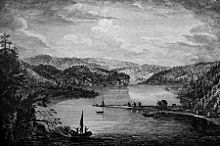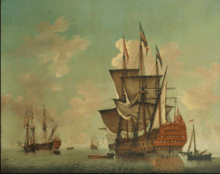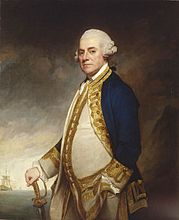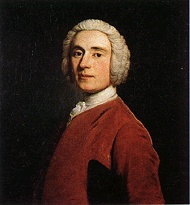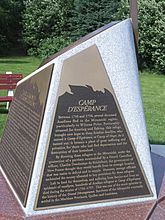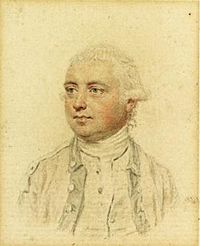Gulf of St. Lawrence campaign (1758) facts for kids
Quick facts for kids Gulf of St. Lawrence campaign |
|||||||
|---|---|---|---|---|---|---|---|
| Part of French and Indian War | |||||||
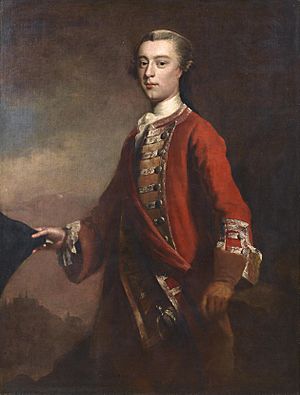 Brigadier-General James Wolfe, British commander |
|||||||
|
|||||||
| Commanders and leaders | |||||||
|
|
||||||
| Units involved | |||||||
| 40th Regiment of Foot |
|
||||||
The Gulf of St. Lawrence campaign was a military operation during the French and Indian War in September 1758. This war was part of a bigger worldwide conflict called the Seven Years' War. During the campaign, British forces attacked villages along the coast of what is now New Brunswick and the Gaspé Peninsula in Canada.
The British leaders were Sir Charles Hardy (for the navy) and Brigadier-General James Wolfe (for the army). After a big battle called the siege of Louisbourg, Wolfe and Hardy led about 1,500 soldiers on nine ships. They arrived at Gaspé Bay on September 5. From there, they sent troops to other places like Miramichi Bay (September 12), Grande-Rivière, Quebec and Pabos (September 13), and Mont-Louis, Quebec (September 14). Over the next few weeks, Sir Charles Hardy's ships destroyed about 200 fishing boats and captured around 200 people.
Contents
Background
The siege of Port Royal happened in 1710. After this, many Acadians, who were French-speaking settlers, did not want to promise their loyalty to Britain. For many years, Acadians helped the French military. They also supplied important goods to French forts like Fortress of Louisbourg and Fort Beausejour.
During the Seven Years' War, the British wanted to stop the Acadians from helping the French. They also wanted to cut off supplies to Louisbourg. So, the British began moving Acadians away from their homes in Acadia. This was known as the Expulsion of the Acadians.
The first wave of these removals started in 1755. The Saint John River valley became a place where Acadians and Algonkian people resisted the British. A French officer named Charles Deschamps de Boishébert et de Raffetot led this resistance. He ordered attacks on British settlements. He also helped Acadian refugees find safe places along the Saint John River.
After the siege of Louisbourg (1758), the British continued to remove Acadians. Different British commanders led campaigns to clear out various areas. Wolfe was sent to lead the Gulf of St. Lawrence campaign.
The Campaign Begins
The main goal of the British in the Gulf of St. Lawrence campaign was to remove resources from the area. This would stop the French from using them. It also aimed to prevent any interference with the planned attack on Quebec in 1759. The settlements in Gaspé Bay and Miramichi were very important to Quebec because they supplied a lot of fish.
Raid on Gaspé Bay
On September 5, 1758, after fighting in the siege of Louisbourg, Wolfe arrived at Gaspé Bay on his ship, HMS Royal William. At the start of the war, about 300 people lived there. By the time of the raid, only 60 remained. The local leader was Pierre Revol.
Sir Charles Hardy took control of the area. The villagers ran away into the nearby woods. British reports say that 15 houses, a sawmill, and a metal shop were destroyed. Of the 60 settlers, 37 were taken by the British and sent back to France. Six people managed to escape. About 18 people were not found.
-
Marquis de Boishébert – Charles Deschamps de Boishébert et de Raffetot (1753)
-
Raid on Gaspé Bay by Captain Hervey Smythe (1758)
Raid on Miramichi Bay
On September 15, Commander James Murray was sent by Wolfe from Gaspé Bay. He arrived at the mouth of Miramichi Bay with 800 soldiers. His ships got stuck because the tide was falling, so they had to wait for the water to rise. This delay gave the Acadians time to escape.
The raid on Miramichi Bay started with an attack on a village called Bay du Vin. About 40 Acadian refugees, led by Father Bonaventure, were living there.
Murray then sent troops across Miramichi Bay to the community known today as Burnt Church. This village had about 30 families. By the time the soldiers arrived, the Acadians had already left. Murray's troops destroyed their food, animals, wigwams, and houses. They also burned the stone church, which is how the community got its name.
Murray's troops could not travel further up the river to Boishebert's refugee camp, called "Camp de l’Espérance," at Beaubears Island. Their boats were too big for the river. These Acadians had escaped an earlier British campaign. Murray returned to Louisbourg on September 24.
-
Raid on Miramichi Bay – Burnt Church Village by Captain Hervey Smythe (1758)
-
Camp d'Espérance Memorial, Beaubears Island
Raid on Grande-Rivière
On September 13, Captain Paulus Irving was sent with several small groups of soldiers to Grande-Rivière, Quebec. The village had 60 houses and about 80 fishing boats. The local leader was de Bellefeuille. When Captain Irving arrived, the villagers had already run away. All the houses and fishing boats were burned. One man and his family, along with five other people, were captured.
A few miles west of Grande-Riviere was a fishing village called Pabos, now known as Chandler, Quebec. When Captain Irving arrived, the people had already fled to the woods. Captain Irving burned 27 homes and 17 other buildings, along with 15 chaloupes (small boats). This left the residents with nothing. Captain Irving also raided Bay de Sauvage, burning six homes and sixteen boats, and Isle Bonaventure, burning six houses and seven boats.
Raid on Mont-Louis
From Gaspé Bay, on September 14, Wolfe sent Major John Dalling to march about 130 miles (209 km) along the shore up the St. Lawrence River. He reached Mont-Louis, Quebec on September 23, after marching for eleven days. Along the way, they captured four people. The local leader was Michel Mahiet. When they arrived at the village, they burned 16 buildings and 5 fishing boats. Dalling managed to capture Monsieur Mahiet and his wife, along with 22 men, 4 women, and 14 children.
Aftermath
Destroying these villages ruined the valuable French fishing industry along the coast. It also cut off important supplies to Quebec, which suffered from a severe food shortage that winter. The next year, the British were successful in the siege of Quebec.
Many Acadians continued to find safety along the Baie des Chaleurs and the Restigouche River. Two years later, the Governor of Cape Breton warned against trying to remove more Acadians. He feared attacks from Mi'kmaq fighters. On the Restigouche River, Boishébert also had a refugee camp called Petit-Rochelle. After Wolfe left the area, the 1760 Battle of Restigouche led to the capture of several hundred Acadians at Boishébert's camp. The following year, a census was taken of the Chaleur Bay to find out where Acadians were hiding. Many of them moved to other places in the Bay of Chaleur.



